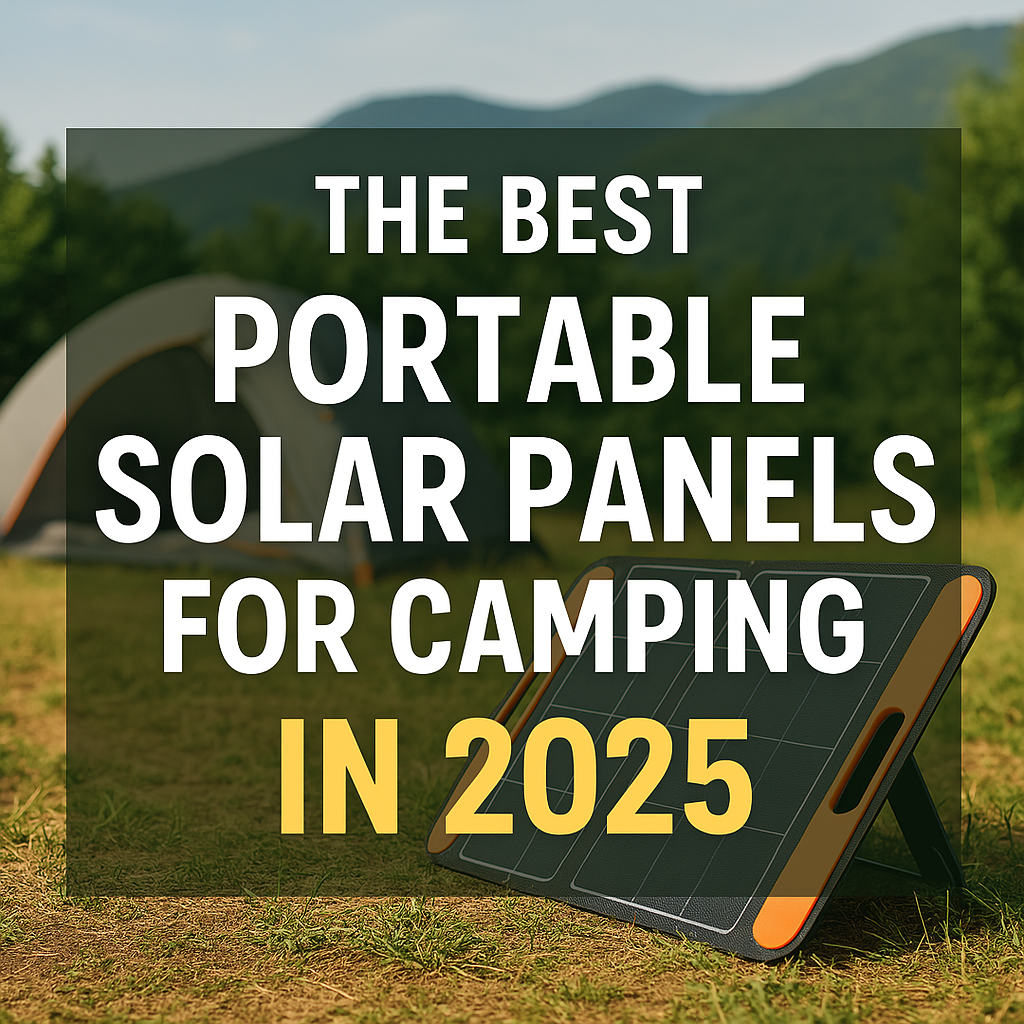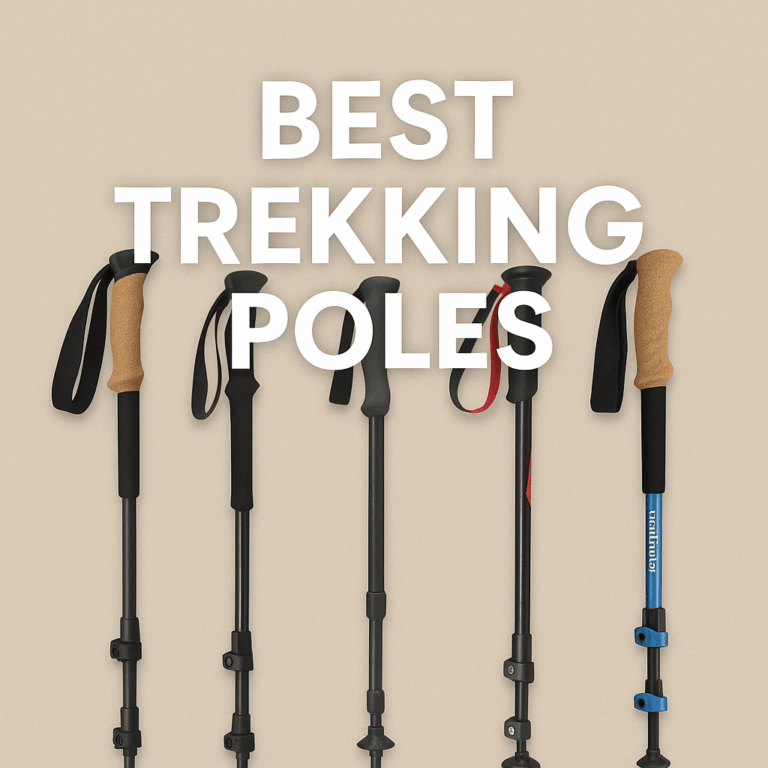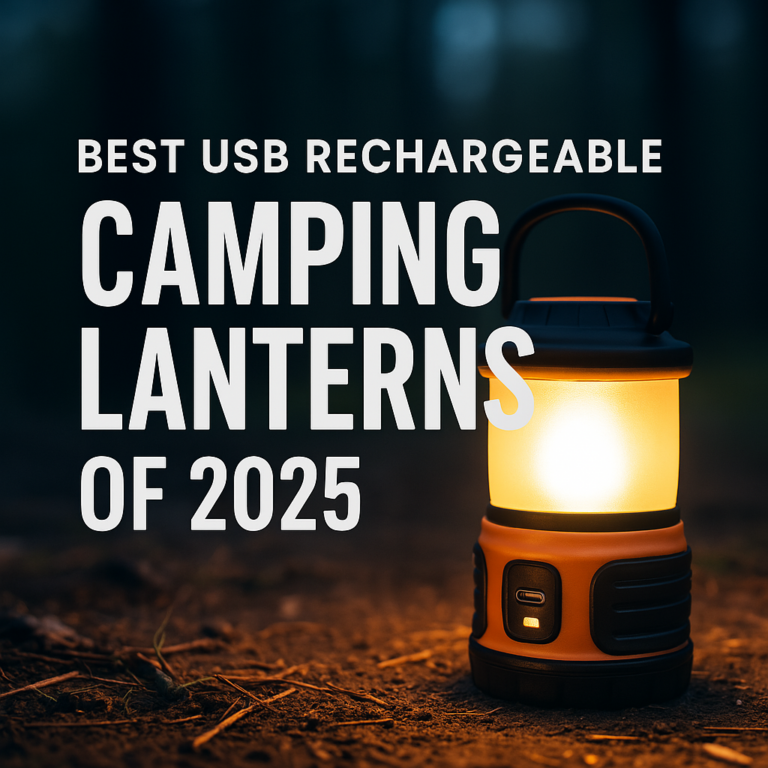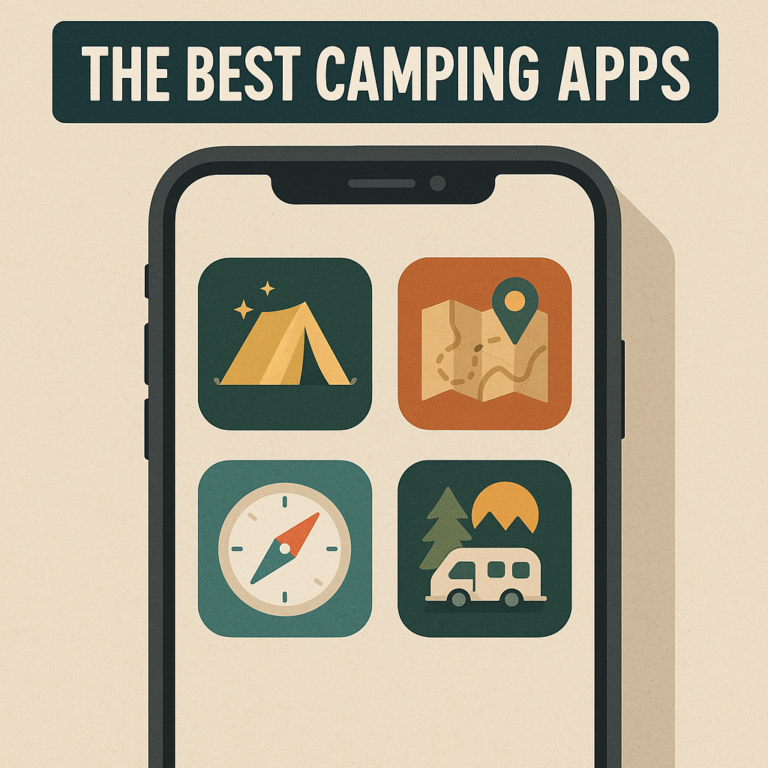The Best Portable Solar Panels for Camping in 2025
Introduction
Power makes camping better! Most of us need to keep our phones and other devices charged, even in remote places. Today’s Best Portable Solar Panels for Camping are light, powerful, and easy to use. I’ve tested many of the Best Portable Solar Panels for Camping to find the top options for every type of camper.
Also check out my guide to camping tech gadgets for 2025. You’ll find great coffee makers, lanterns, and other gear to make camping more fun.
Did you know 8 out of 10 campers bring devices that need charging? Let’s look at the Best Portable Solar Panels for Camping to keep you powered up! For a complete overview of all your options, check out our power solutions for devices while camping complete guide.
Best Portable Solar Panels for Camping
When choosing the Best Portable Solar Panels for Camping, consider factors like wattage, weight, durability, and price. The Best Portable Solar Panels for Camping should balance power output with portability for your specific needs.
1. Jackery SolarSaga 100W Solar Panel
Features
This Jackery SolarSaga 100W converts 23% of sunlight into power, better than most others at this price.
It works well even when it’s not perfectly sunny. I’ve used it in shady forests and still charged my phone.
It folds like a briefcase with a handle. When packed, it’s as small as a laptop bag and fits easily in any car.
When open, it catches plenty of sunlight. You can move it to follow the sun throughout the day.
The built-in USB ports are very handy. With USB-A and USB-C on the back, you can plug your phone directly into the panel.
It’s tough too. Strong plastic covers the solar cells instead of glass. It handles bumps and drops just fine.
I set mine up early each morning. By breakfast, my phone and headlamp are ready for the day. For longer trips, I pair it with a power bank for nighttime use. Learn more about pairing options in our complete power solutions guide.
Setup takes seconds – just unfold, point at the sun, and plug in.
Pros
It’s lightweight at just 10 pounds. My old solar setup was twice as heavy for the same power.
This matters when carrying gear from your car to your campsite. Being lighter means I actually bring it instead of leaving it behind.
It works in many light conditions. Full sun is best, but it still works on cloudy days. I get about 60-70 watts in bright sun and 20-30 watts when cloudy.
Charging is fast. My phone reaches 80% in about 90 minutes of direct sun. My tablet charges fully in one sunny day. Even my laptop gets a decent charge in a few hours.
A friend bought one after seeing mine during a desert trip. He was amazed how quickly it charged his devices compared to his old panel.
It handles light rain and morning dew without problems. I accidentally left it out during a quick shower once, and it still worked perfectly.
The kickstand lets you aim it directly at the sun as the day goes on. This small feature really improves your power output.
Cons
There’s no built-in battery. Power stops when the sun sets. You’ll need a separate power bank for nighttime power.
For a weekend trip last fall, I bought a power bank to use with it. This added cost and weight, though having both parts separately is actually useful.
It’s splash-proof but not waterproof. In heavy rain, you must pack it up quickly. You need to watch the weather and might lose charging time during storms.
I learned this on a mountain trip when a storm came suddenly. I rushed to protect my panel and lost charging time. Now I always check the weather.
It needs space when open. At 48 x 21 inches, you need a good sunny spot. In tight campsites or woods, finding enough open space can be tricky.
At a crowded festival, I struggled to find space without shadows from nearby tents. Sometimes good placement means setting up away from your main camp.
It doesn’t come with a case. I bought a padded one for $30.
My Experience
At $299, this Jackery panel has been one of my best outdoor purchases. It’s very reliable and has survived packed cars, dusty deserts, and light rain.
If you want good power in a portable, tough package, the SolarSaga 100W is excellent. Just be ready for your friends to ask if they can use your “charging station” when they see how well it works!
2. Bluetti PV120 Solar Panel
Features
This Bluetti PV120 delivers serious power. At 120W, it beats many competitors at this price. More watts means faster charging for all your gear.
It uses premium solar cells that work well even in poor light, like early morning or cloudy days. This means more charging hours each day.
The special coating lets more light through while staying tough. You get better results without losing durability.
The four-fold design works great for camping. When folded, it fits in any trunk. When open, it creates a large surface to catch plenty of sun.
Strong kickstands let you angle it perfectly toward the sun. They’re stable enough for windy days, important when you leave it set up while hiking.
It has multiple output options. With DC and USB ports, you can charge phones directly or connect to a power bank without extra adapters. For more on power bank compatibility, see our power solutions guide.
Pros
The 120W capacity makes charging much faster. With a power bank, I can charge all my camping gear in one sunny day. This extra power really helps when charging multiple devices.
During a week at Joshua Tree, this panel powered everything at our camp. Two phones, a speaker, headlamps, and even a drone stayed charged the whole trip.
It works well even on cloudy days. I’ve measured 50-60W output with overcast skies, enough to charge phones and small devices.
During a rainy Northwest trip, we had mixed weather. Even with brief sunny breaks, the Bluetti kept making useful power.
It’s built to last. The tough coating resists scratches and impacts. After a year of regular use, mine shows almost no wear.
Once, it fell from our table onto rocks. Apart from a small scuff, it worked perfectly. This toughness gives peace of mind in remote areas.
When folded, it’s surprisingly compact. At 21 x 16 inches and under 1 inch thick, it packs easily in a crowded car.
Cons
At 13.8 pounds, it’s not light. Fine for car camping, but too heavy for hiking. This weight is the trade-off for higher power and tougher build.
During one trip, our campsite was a quarter-mile from parking. Carrying the panel with other gear was tiring.
It’s pricey at $349. While worth it for frequent campers, casual users might find it hard to justify.
I thought about it for months before buying. After a year, I’ve gotten my money’s worth, but it was still a big purchase.
The folding design means more parts that could break over time. I’m careful when opening and closing it to avoid damage.
During a windy desert day, sand got in one hinge. After cleaning, it worked fine, but this showed the need for proper care.
It’s not fully waterproof. It handles dew or light drizzle, but in heavy rain, you must pack it away quickly.
My Experience
The Bluetti PV120 is essential for my longer trips. During a 10-day off-grid adventure, it powered all our devices and even a small fridge (with a power bank).
Its reliability alone makes it worth the cost. Knowing I can make plenty of power anywhere gives great peace of mind.
At $349, it’s a good value for regular campers who need reliable power. Its mix of high power, toughness, and decent portability makes it a top choice.
If you need more power than standard panels and don’t mind some extra weight, the Bluetti PV120 is excellent. Just be ready for friends asking to use your “solar station!”
3. BigBlue SolarPowa 100 ETFE
Features
This BigBlue SolarPowa 100 ETFE offers amazing value. The 100W output matches premium brands at a much lower price.
The ETFE coating is rare at this price. This special plastic lets more light through while staying tough. Most panels this cheap use lower-quality coatings.
It converts 23.5% of sunlight to electricity. This high rate helps it work well even in poor light, giving you more charging hours each day.
Smart charging tech identifies your devices and sends the right amount of power. This prevents damage and speeds up charging for any device.
The four-fold design packs small, about the size of a laptop bag. Open, it creates a big surface to catch sun without taking up too much space.
The built-in voltage control protects your devices. It prevents power surges during changing light, which could harm expensive electronics.
Pros
The value is amazing. At around $199, it performs like panels costing $100 more. Budget campers get great power without breaking the bank.
During a two-week road trip, it kept all our gadgets charged daily. Despite being much cheaper than my friend’s fancy panel, it made similar power.
Multiple output options let you charge several devices at once. I’ve charged my phone, headlamp, and power bank all at the same time. Check our complete guide for power bank recommendations.
On family trips, this means no fighting over who charges first! Everyone plugs in together, keeping peace in camp.
At 9.3 pounds, it’s lighter than many similar panels. You can carry it a good distance from your car without too much strain.
At a lake campsite that needed a quarter-mile walk from parking, I carried the panel and a cooler without much trouble.
It handles light rain and morning dew well. I left it out during a quick shower last summer, and it worked perfectly after.
Cons
The kickstands could be better. They work on flat ground but struggle on uneven surfaces. In wind, you might need rocks to keep it steady.
During a desert trip, I used water bottles to weigh down the corners. Better stands would be a nice upgrade.
Like most panels, it has no built-in battery. It only makes power in sunlight. You’ll need a separate power bank for a complete system.
For a longer trip, I had to buy a power bank separately. This adds to the total cost, though it gives more flexibility.
The cables could be longer. They work when devices are right next to the panel, but sometimes you want your phone in shade while the panel sits in sun.
I bought extension cables after finding the included ones too short. This added $15 but made the system much more useful.
The carrying case works but lacks good padding. If you’re rough with gear, you might want better protection.
My Experience
The BigBlue SolarPowa is my top pick for friends just starting with solar. During a mountain trip last summer, it powered five people’s devices through a long weekend.
I’ve used it at home during power outages to keep phones and emergency lights working. It’s useful beyond just camping trips.
At $199, the BigBlue SolarPowa 100 ETFE brings good solar power to more outdoor lovers. After a year of use in all conditions, it still works perfectly despite its lower price.
If you want affordable solar without giving up too much performance, this panel is perfect. Just be ready to make small adjustments to get the most from it!
4. Anker SOLIX 100W Foldable Solar Panel
Features
This Anker SOLIX 100W comes from a trusted charging brand. Anker is known for quality power products, and this solar panel continues that tradition.
It uses premium solar cells with 23% efficiency. This high rate means more power from less surface area, even with limited sun. I got good power even in partial shade.
Smart IQ tech adjusts charging based on what’s plugged in. Whether it’s a phone, tablet, or power bank, it optimizes power flow for the fastest safe charging.
The three-panel folding design balances size and portability. Open, it’s about 20 x 42 inches. Folded, it’s just like a laptop bag.
Multiple ports give great options. With USB-A, USB-C, and DC outputs, you can charge almost any device directly or store power for later.
The kickstand system allows precise sun-tracking. Unlike many panels with limited positions, the SOLIX can be aimed exactly at the sun all day.
Pros
Reliability is outstanding. While some panels vary day to day, the SOLIX delivers steady power output. During a week in the desert, it performed consistently despite big temperature changes.
When other campers’ panels struggled in high heat, the SOLIX kept working perfectly. This reliability lets you plan your power needs with confidence.
Build quality is top-notch. Strong materials and reinforced corners resist damage from camping bumps. The durable coating protects cells while letting light through.
Once, it fell from a table onto rocks. Despite the fall, it kept working perfectly. This toughness gives peace of mind in remote places.
Water resistance beats many rivals. With IPX4 rating, it handles splashes from any direction. No need to panic if light rain starts while you’re away from camp.
While camping by a lake, a wave splashed the panel. After a quick wipe-down, it worked fine. This weather resistance is perfect for outdoor use.
Charging speed is impressive. My phone typically charges from 20% to 80% in about 90 minutes of good sunlight. Fast charging means more time enjoying your trip.
Cons
It’s expensive at $279. While performance justifies this for frequent users, casual campers might find it hard to justify compared to budget options.
I debated for weeks before buying, finally deciding my monthly camping trips made it worthwhile. After a year, I feel it’s been worth it, but the initial cost is high.
At 10.7 pounds, it’s too heavy for backpacking. The weight comes from the solid build and high power output.
During a trip with a half-mile hike to our campsite, the panel’s weight was noticeable. For drive-up camping, weight matters less.
The three-panel design means more hinge points that could break compared to simpler designs. While I’ve had no problems in a year of use, I’m careful when folding it.
After six months, one hinge became slightly stiff. A bit of silicone lube fixed it, but this showed the need for proper maintenance.
The included case could be better padded for the price. I bought a separate case with more padding for $25.
My Experience
The Anker SOLIX has become essential for my camping trips. During a two-week off-grid adventure, it reliably powered all our devices, including phones, tablets, headlamps, and a drone.
It’s also great during home power outages. After a storm knocked out power for three days, neighbors came over to charge their phones when their batteries died.
At $279, the Anker SOLIX 100W is a premium but worthy investment for frequent campers. After extensive use in all conditions, its performance and durability remain impressive.
If you value reliability, toughness, and performance, and camp often enough to justify the cost, the Anker SOLIX 100W is excellent. Just be ready to become your group’s charging station!
5. Renogy 100W Foldable Solar Panel
Features
This Renogy 100W Foldable Solar Panel has a solid 21% efficiency rating. The quality cells pull good energy from available sunlight, giving useful charging power even in mixed conditions.
The briefcase design is perfect for camping. Closed, it’s about the size of a laptop bag for easy storage. Open, the two panels create a good surface for catching sun.
The aluminum frame adds strength without too much extra weight. Unlike plastic-framed rivals, this metal build provides better durability. The frame also helps cooling, which improves efficiency in hot weather.
Adjustable kickstands let you aim perfectly at the sun. The legs set to multiple angles, helping you follow the sun across the sky for maximum power all day.
The built-in charge controller is a big plus. This waterproof controller prevents battery damage and makes it safe to connect directly to 12V batteries. This all-in-one approach simplifies your power system. See our power solutions guide for more on battery compatibility.
The case has reinforced corners and a good handle. Heavy-duty latches keep everything secure during travel, and the grip makes it comfortable to carry.
Pros
Durability is outstanding. The glass covering, aluminum frame, and quality build create a robust panel that handles rough outdoor use. After a year of regular trips, mine shows barely any wear.
During a desert trip, sand blew across the panels for hours. They still worked perfectly and showed no damage after cleaning. This toughness is crucial when you’re far from civilization.
The built-in charge controller saves money and hassle. This component prevents battery damage while optimizing power flow. Having it built in means one less thing to buy and connect.
Friends new to solar were impressed by how easy the system was to use. The simple setup made it accessible even to camping newbies.
Built-in protection prevents power drain during low light. This feature preserves battery power when the sun isn’t shining. It’s especially helpful during dawn and dusk.
It works with many battery types (sealed, gel, flooded, and lithium) without extra adapters. Whatever power storage you prefer, this panel works with it.
You can easily add more panels later if your needs grow. I started with one and added a second for family trips, doubling my power without replacing anything.
Cons
At 26.6 pounds with the case, it’s heavy. The aluminum frame adds durability but also weight compared to lighter options. This makes it poor for long carries from your vehicle.
On a trip where we camped a half-mile from parking, the weight became a real issue. I made a separate trip just for the panel. For drive-up sites, weight matters less.
It takes up space when open. At 40 x 27 inches, you need a good-sized sunny area. In wooded sites or tight spaces, finding the right spot can be challenging.
During a forest camping trip, I placed the panel far from our tent to find enough sun. This required extra cables and more planning.
At $259, it costs more than basic options. While the quality justifies this for regular users, occasional campers might prefer cheaper alternatives.
I considered it for months before buying. After lots of use, I feel it’s been worth it, but the cost is significant compared to simpler systems.
Despite the quality build, the case latches could be stronger. After eight months of use, one latch showed wear. I added a bungee cord as backup.
My Experience
The Renogy 100W has become my top recommendation for serious campers needing reliable power. During a two-week off-grid trip, it kept our 12V system charged continuously, powering lights, phones, and a small fridge without problems.
It’s also great during home power outages. The ability to directly charge a deep cycle battery makes it valuable beyond just camping.
At $259, the Renogy 100W Foldable Solar Panel offers great value for regular campers with significant power needs. After extensive use in all conditions, its performance and durability remain impressive.
If you need a tough, efficient solar solution for regular camping, especially with 12V systems, the Renogy 100W Foldable Panel is excellent. Just plan for the weight when preparing your trips!
Conclusion
Finding your Best Portable Solar Panels for Camping means matching your power needs with factors like weight, size, and ease of use. From light panels under 10 pounds to bigger ones with maximum power, there’s something for every camper. The Best Portable Solar Panels for Camping are the ones that fit your specific camping style and power needs! Whether at a remote site or a drive-up campground, these Best Portable Solar Panels for Camping keep your devices running in the great outdoors.
For more comprehensive information about powering your devices while camping, be sure to check out our complete power solutions guide. If you’re interested in building your own system, our guide on DIY Solar Charging Systems will walk you through the process step by step.
How do you stay powered while camping? Share your stories and happy camping!







